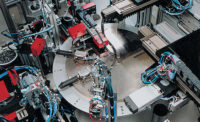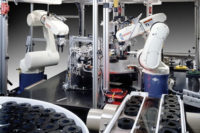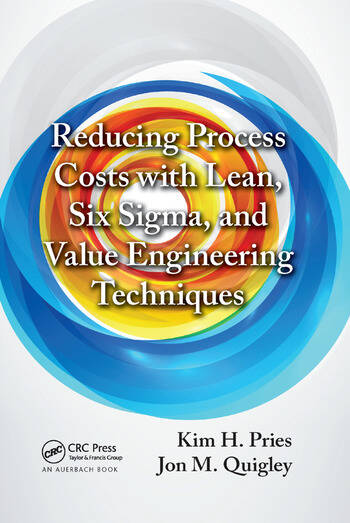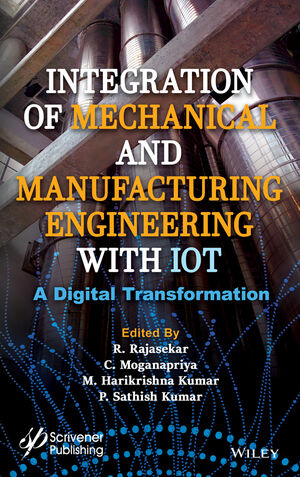Working Profitably With Integrators
Communication is key to successful automation projects.
The same thing happens every day in the world of manufacturing. Many engineers fail to communicate their actual goals to systems integrators. Instead, they often focus on dream goals that convey their wishes for automated equipment.
Integrators play a crucial role in ensuring that automation projects achieve a cost-effective balance among key issues such as flexibility, throughput, time-to-market and cost. But, manufacturing engineers must partner with integrators early in the machine building process to gain the maximum benefits from both the equipment and the integrator’s services.
For both parties to achieve a win-win relationship that delivers the right automated assembly systems at the right time at the right price, communication is critical. Unfortunately, today’s chaotic business conditions are disrupting traditional communication patterns.
Intense Competition
Many systems integrators are struggling to survive intense competition and a depressed business climate. “The market has shifted,” says Tom Bieber, president of Apex Automation Inc. (Elizabethtown, PA). “Three to five years ago, people came to us and lived with whatever price and delivery time we told them. Now, there has been a 180-degree shift. Today, customers tell us when they need to have it and what they will pay.”
“We’ve seen a huge change in the way business is done because of a number of external forces,” notes Gary Seibert, general manager of Merritech (Saginaw, MI). For instance, product life cycles are shorter, equipment delivery times are shorter, customer expectations are higher and manufacturers hold on to their money until the last possible moment. “We’re operating in a survival mode right now,” adds Seibert. “It’s tough to get paid these days because companies are watching every penny.”
The competition for new customers has also intensified. “There are a lot of hungry integrators out there trying to get business,” reports Jim Story, president of Spectra Technologies Inc. (Euless, TX). “In the past, we typically encountered three or four other integrators in the bidding process. Today, it’s not unusual to be competing against seven or eight integrators.”
And, to make matters worse, some companies are falsely labeling themselves “integrators” to attract customers. “Other ‘integrators’ are assuming the title without the qualifications,” claims Mike Perreault, vice president of Midmac Systems Inc. (St. Paul, MN). “There are a lot of me-too companies out there that need to provide some kind of an edge over the competition. The biggest culprit is the packaging industry.”
According to Perreault, those impostors don’t provide the project support and engineering services that customers assume. Unfortunately, customers often don’t find that out until after they are committed to the vendor. As a result, they end up with unforeseen costs and problems.
“A lot of us are chasing less business,” adds Story. “Often, the manufacturing plants we deal with in the United States are involved in internal competition. They’re bidding for assembly projects against offshore plants. That puts tremendous pressure on integrators.”
In the late 1990s, systems integrators derived a large chunk of their revenue from the electronics industry. Unfortunately, most of that once-lucrative business has dried up. Many original equipment manufacturers (OEMs) have shifted production to offshore plants or simply outsourced assembly tasks to electronics manufacturing services (EMS) providers.
Several years ago, the fiber optics industry was crying out for automation, but that demand has also shriveled. Today, many integrators depend on medical device manufacturers for their bread and butter, in addition to defense contractors and consumer product manufacturers.
Another traditionally strong customer base for systems integrators--the auto industry--has changed its automation buying habits. Automakers are constantly clamoring for price reductions. And, despite trade union pressure, some have turned their back on domestic machine builders in favor of overseas competitors.
“Automakers no longer put any value on relationships,” says one bitter observer. “They tend to act like dictatorships. They rule and we’re just a piece of meat. Tier 1 and Tier 2 suppliers usually aren’t as hostile as OEMs, but they still pass on price pressures to us.”
Many automakers are trying to wring out as much cost as possible from their capital equipment expenditures. They have been putting extra pressure on their suppliers in an effort to control costs and boost quality. For instance, many manufacturers have increased the number of engineers assigned to work with suppliers to come up with cost-cutting ideas.
Through value engineering efforts, OEMs are searching for ways to remove product features and redesign components. Some bonus programs are based on how much money engineers and purchasing professionals can slash from automated assembly machines and other capital equipment.
“Customers demand more value from integrators because they are under intense pressure to compete and control automation program costs,” says Mike Cybulski, vice president of systems operations at ATS Automation Tooling Systems Inc. (Cambridge, ON). “We’ve developed a cost of ownership modeling tool where we can document the costs of using the correct tools over the life of one or many programs to assist the customer decision making process.”
Changing Roles
Because of cost pressures, manufacturing engineers are facing more and more scrutiny from management. “Today, the cost of technology has to be recovered in only 3 to 5 years, which adds to the pressure,” notes Seibert. “Product life cycles are shorter and shorter.”
As a result, most engineers are emphasizing productivity and looking for turnkey solutions that provide long-term flexibility. They want equipment that is reconfigurable. “Development of reusable, scalable and flexible automation benefits [manufacturers because the equipment] can be used for many programs,” says Cybulski.
According to Midmac’s Perreault, there is a direct correlation between product life cycle and automation technology. “With short life cycles, customers are typically more interested in flexible, reconfigurable machines,” Perreault points out. “Companies may be willing to gamble more with technology because the product life is short. Manufacturers are less likely to push the technology envelope with well-established products. They are more interested in process technology that they can rely upon to meet product longevity.”
The growing popularity of lean manufacturing also presents less opportunity to add “bells and whistles” to automation projects. In fact, most systems integrators claim they are building more and more lean machines. “In the past, the majority of assembly lines we built were fully automated, palletized systems,” recalls Seibert. “Today, because of lean manufacturing initiatives, about one-third of what we build is lean, stand-alone cells.”
“People are definitely moving toward simpler machines,” adds Apex Automation’s Bieber. “We’re seeing more requests for smaller equipment.” That trend has affected integrators’ pocket books. For instance, Bieber says the average piece of equipment his company quoted in the past was $380,000. Today, the average quote is around $200,000.
In a lean manufacturing environment, automation is still very important. “However, more error proofing is needed and integrators must offer a range of pre-engineered, standard automation modules that suit this environment,” notes Cybulski.
Many manufacturing engineers have been forced to change the scope of their daily routine. Because of staffing and budget cutbacks, they simply have less time and less resources to devote to project management. The changing role of engineers is challenging the traditional integrator-customer relationship.
“Integrators are more responsible for the total project than ever before,” says Cybulski. “Downsizing has caused some customers to depend on [integrators] for more engineering and prototyping, for example.”
“We’re seeing more design-by-committee and collaborative engineering efforts,” says Seibert. The practice is becoming more popular among vehicle manufacturers. For instance, Ford Motor Co. (Dearborn, MI) and General Motors Corp. (Detroit) recently announced a joint-venture to develop a new six-speed automatic transmission for sport-utility vehicles. In January, Deere & Co. (Moline, IL) and Bombardier Inc. (Valcourt, Quebec, Canada) announced a strategic alliance to develop all-terrain utility vehicles.
Those strategic alliances are intended to expand the business opportunities for both parties involved. While collaborative engineering offers numerous benefits to OEMs, it adds an additional challenge to integrators.
“Engineers are spending more time in meetings,” says Seibert. “In the past, we had one go-to-guy who we could get answers from. Now, everything has to go to a committee. That often requires negotiations, which makes it harder to meet short time cycles.
“We really need someone who can make sound engineering and process decisions quickly,” adds Seibert. “In the past, we usually had a 5-day turnaround. But, there’s no opportunity in today’s hectic product schedules to devote that kind of time for reviewing drawings or controls. Many decisions need to be made quickly in just one meeting.”
Integrators also claim that the widespread practice of concurrent engineering is causing havoc. “Frequently, we’re designing assembly processes and equipment at the same time that the product is being developed,” says Story. “As a result, we have to put off designing some key components, such as fixtures, grippers and feed mechanisms, as late as possible.”
Experience Gap
Due to corporate downsizings, layoffs and early retirements, a serious experience gap exists in the manufacturing field. The talent pool is drying up and many older, seasoned engineers are being replaced by fresh-faced individuals who lack practical experience.
“As a result, a simple problem often becomes a monumental problem,” says Seibert. “When communicating with inexperienced people, they can’t always give you a simply ‘yes’ or ‘no’ answer. That adds to the overall time of most projects. It’s dramatically impacting our relations with customers. Some individuals actually end up costing us more money to do business with.”
Many manufacturers fail to provide mentoring programs that pair veteran technical talent with new blood coming through the door. “Inexperience definitely puts more stress on us,” says Story. “For instance, it’s not unusual to go through several project managers during a 9-month project. That puts a lot more pressure on documentation. We have to document all changes in case a new guy takes over midway through the project and wants to know why something was done a certain way.”
In the past, “you could sit down across a table and hammer out problems,” claims Bieber. “It was easy to have a dialogue and discuss cost concerns or technical problems. Many young guys are fresh out of school and don’t know what they want. We find ourselves doing more education today.
“Often, the people we’re dealing with don’t know what type of questions to ask up front,” adds Bieber. “In the past, a company didn’t throw young engineers into a big project. You learned about the business gradually. But, that’s not the case today.”
When working with fresh talent, integrators find themselves doing a lot more hand-holding. However, Story says working with unseasoned engineers is not all bad. “If we’re willing to spend extra time and effort up front, it gives us an opportunity to differentiate ourselves,” he explains. “Many young engineers are smart and want to make a name for themselves. They’re willing to try new things if you spend time with them.”
Separate Goals
Most systems integrators claim engineers don’t get them involved in projects early enough. “The most important factor for success in an automation project is the early involvement of an integrator,” claims Automation Tooling Systems’ Cybulski. “Early involvement means better specifications, less technical risk, fewer changes and a better understanding of the entire project.”
“When a customer doesn’t get an integrator involved early, they tend to write a spec that’s too vague,” adds Merritech’s Seibert. “It leads to a lot of confusion.”
Making matters worse, Seibert says the planning process has accelerated over the last 5 years, due to time-to-market pressures. “The better we understand customer expectations up front, we have a better chance of delivering more cost-effective solutions,” he claims.
Cybulski says manufacturing engineers don’t always fully share the risks, technical challenges or manufacturing issues they have encountered in the past. Customers also fail to provide part information and samples. “Sharing this information helps the integrator help the customer in finding the best possible automation solution for their needs,” explains Cybulski. “Careful planning and communication can ensure that the customer is getting what he needs over the life of the project. Early communication with the entire customer project team ensures that the correct system design will meet both the short- and long-term needs for the customer.”
“The quality of a proposal is directly proportional to the quality of information provided,” says Midmac’s Perreault. “Many engineers forget to talk to the operator. They usually have a lot of good information and insights to share. We always ask for a 5-minute videotape of the production process to evaluate how the operator interacts with assembly equipment.”
According to Perreault, the first thing engineers should do is to identify a goal, and then let an integrator decide the best path to take. Unfortunately, he says many engineers fail to clearly define their needed goals vs. their wish goals. For instance, a wish goal may require a throughput speed of 60 parts per minute, when the actual goal is 40 parts per minute.
As a result, the price difference between actual goals and wish goals can be substantial. “Too many times, the customer says ‘This is what I need,’” says Perreault. “But, it’s a wish goal that typically ends up costing two or three times more than what’s necessary.”
Perreault says goals should be separated into three parts: Where are you at now? What do you need to achieve? What would you like to achieve? “Some goals are easily obtained, but others are unreal and costly,” concludes Perreault. “It’s important to be honest with your integrator.”
Looking for a reprint of this article?
From high-res PDFs to custom plaques, order your copy today!









